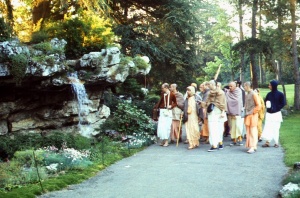CC Madhya 9.79 (1975)

A.C. Bhaktivedanta Swami Prabhupada
TEXT 79
- pāpa-nāśane viṣṇu kaila daraśana
- śrī-raṅga-kṣetre tabe karilā gamana
SYNONYMS
pāpa-nāśane—at the place named Pāpanāśana; viṣṇu—Lord Viṣṇu; kaila—did; daraśana—visiting; śrī-raṅga-kṣetre—to the holy place named Śrī Raṅga-kṣetra; tabe—then; karilā—did; gamana—departure.
TRANSLATION
After visiting the holy place named Śiva-kṣetra, Caitanya Mahāprabhu arrived at Pāpanāśana and there saw the temple of Lord Viṣṇu. Then He finally reached Śrī Raṅga-kṣetra.
PURPORT
According to some, the place known as Pāpanāśana was located eight miles southwest of Kumbhakonṇam. Others say that in the district of Tinebheli there is a city known as Pālamakoṭā and that Twenty miles west of there is the holy place known as Pāpanāśana, near the river Tāmraparṇī. Śrī Raṅga-kṣetra is a very famous place. Near Tiruchchirāpalli is a river named Kāverī, or Kolirana. A city known as Śrī Raṅgam is located on this river in the district of Tanjoreāñ, about ten miles west of Kumbhakonṇam. The Śrī Raṅga temple is the largest in India, and there are seven walls surrounding it. There are also seven roads leading to Śrī Raṅga. The ancient names of these roads are the road of Dharma, the road of Rājamahendra, the road of Kulaśekhara, the road of Ālināḍana, the road of Tiruvikrama, the Tirubiḍi road of Māḍamāḍi-gāisa, and the road of Aḍa-iyāvala-indāna. The temple was founded before the reign of Dharmavarma, who reigned before Rājamahendra. Many celebrated kings like Kulaśekhara, and others such as Ālabandāru, resided in the temple of Śrī Raṅgam. Yāmunācārya, Śrī Rāmānuja, Sudarśanācārya and others also supervised this temple.
The incarnation of the goddess of fortune known as Godādevī, who was one of the twelve liberated persons known as divya-sūris, was married to the Deity, Lord Śrī Raṅganātha. Later she entered into the body of the Lord. An incarnation of Kārmuka, Tirumaṅga (one of the Alwars), acquired some money by stealing and built the fourth boundary wall of Śrī Raṅgam. It is said that in the year 289 of the Age of Kali, the Alwar of the name Toṇḍaraḍippaḍi was born. While engaged in devotional service, he fell victim to a prostitute, and Śrī Raṅganātha, seeing His devotee so degraded, sent one of His servants with a golden plate to that prostitute. When the golden plate was discovered missing from the temple, there was a search, and it was found in the prostitute's house. When the devotee saw Raṅganātha's mercy upon this prostitute, his mistake was rectified. He then prepared the third boundary wall of the Raṅganātha temple and cultivated a tulasī garden there.
There was also a celebrated disciple of Rāmānujācārya's known as Kūreśa. Śrī Rāmapillā was the son of Kūreśa, and his son was Vāgvijaya Bhaṭṭa, whose son was Vedavyāsa Bhaṭṭa, or Śrī Sudarśanācārya. When Sudarśanācārya was an old man, the Mohammedans attacked the temple of Raṅganātha and killed about twelve hundred Śrī Vaiṣṇavas. At that time the Deity of Raṅganātha was transferred to the temple of Tirupati in the kingdom of Vijaya-nagara. The governor of Gingeeṅ, Goppaṇārya, brought Śrī Raṅganātha from the temple of Tirupati to a place known as Siṁha-brahma, where the Lord was situated for three years. In the year 1293 Śaka (A.D. 1372) the Deity was reinstalled in the Raṅganātha temple. On the eastern wall of the Raṅganātha temple is an inscription written by Vedānta-deśika relating how Raṅganātha was returned to the temple.